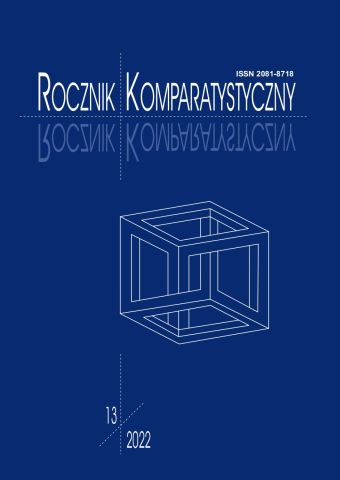





| Authors: |
Magdalena
Berechowska

Uniwersytet Szczeciński |
| Keywords: | Frankenstein adaptation ballet monstrosity |
| Data publikacji całości: | 2022 |
| Page range: | 16 (271-286) |
Cytowanie: Berechowska, Magdalena. “Monstrosity in a Ballet Adaptation of Mary Shelley’s Frankenstein”.Rocznik Komparatystyczny 13 (2022): 271–286. DOI: 0.18276/rk.2022.13-14.
| 1. | Au, Susan. Ballet and Modern Dance. London: Thames & Hudson, 2016. |
| 2. | Benshoff, Harry M. Monsters in the Closet: Homosexuality and the Horror Film. Manchester: Manchester University Press, 1997. |
| 3. | Bride of Frankenstein [film]. Directed by James Whale. USA: Universal Pictures, 1935. |
| 4. | Crook, Nora. “Foreword.” Global Frankenstein. Eds. Carol Margaret Davison, Marie Mulvey-Roberts. Cham: Palgrave Macmillan, 2018. vii–x. |
| 5. | Davison, Carol Margaret. “Monstrous, Mortal Embodiment and Last Dances: Frankenstein and the Ballet.” Global Frankenstein. Eds. Carol Margaret Davison, Marie Mulvey-Roberts. Cham: Palgrave Macmillan, 2018. 109–129. |
| 6. | Erle, Sybille, Helen Hendry. “Monsters: Interdisciplinary Explorations in Monstrosity.” Palgrave Communications 6.53 (2020): 1–7. |
| 7. | Frankenstein [ballet]. Choreographed by Liam Scarlett. Royal Opera House and SanFrancisco Ballet, 2016. |
| 8. | Frankenstein [film]. Directed by James Whale. USA: Universal Pictures, 1931. |
| 9. | Friedman, Lester D., Allison B. Kavey. Monstrous Progeny: A History of the Frankenstein Narratives. New Brunswick: Rutgers University Press, 2016. |
| 10. | Garland-Thomson, Rosemarie. “Far from the Tree: Choreographies of Family Obligation in the Ballet of Frankenstein.” Literature and Medicine 36.2 (2018a): 464–494. |
| 11. | ------. “Unexpected Creatures: Procreative Liberty and the Frankenstein Ballet.” Hastings Center Report 48.6 (2018b): 18–20. |
| 12. | Griggs, Yvonne. The Bloomsbury Introduction to Adaptation Studies: Adapting the Canon in Film, TV, Novels and Popular Culture. London: Bloomsbury, 2016. |
| 13. | Hadlock, Heather. “Opera and Gender Studies.” The Cambridge Companion to Opera Studies. Ed. Nicholas Till. New York: Cambridge University Press, 2012. 257–275. |
| 14. | Haggerty, George E. “What Is Queer about Frankenstein?” The Cambridge Companion to Frankenstein. Ed. Andrew Smith. Cambridge: Cambridge University Press, 2016. 116–127. |
| 15. | Halberstam, Judith. Skin Shows: Gothic Horror and the Technology of Monsters. Durham: Duke University Press, 1995. |
| 16. | Jennings, Luke. “Frankenstein Review – A Monster Hash from the Royal Ballet.” https://www.theguardian.com/stage/2016/may/08/frankenstein-royal-ballet-review-liam-scarlett [accessed: 6.08.2022]. |
| 17. | Kavey, Allison B., Lester D. Friedman. “Introduction: Chemistry, Disability, and Frankenstein.” Literature and Medicine 36.2 (2018): 264–268. |
| 18. | Laplace-Sinatra, Michael. “Science, Gender and Otherness in Shelley’s Frankenstein and Kenneth Branagh’s Film Adaptation.” European Romantic Review 9.2 (1998): 253–270. |
| 19. | Mary Shelley’s Frankenstein [film]. Directed by Kenneth Branagh. USA, Japan: TriStar Pictures, 1994. |
| 20. | McGavran, James Holt. “‘Insurmountable Barriers to Our Union’: Homosocial Male Bonding, Homosexual Panic, and Death on the Ice in Frankenstein.” European Romantic Review 11.1 (2000): 46–67. |
| 21. | Perkowitz, Sidney, Eddy Von Mueller. “Epilogue: The Next Two Hundred Years of Frankenstein.” Frankenstein: How a Monster Became an Icon. The Science and Enduring Allure of Mary Shelley’s Creation. Eds. Sidney Perkowitz, Eddy Von Mueller. New York: Pegasus Books, 2018. 217–220. |
| 22. | Picart, Caroline Joan, Frank Smoot, Jayne Blodgett. The Frankenstein Film Sourcebook. Westport: Greenwood Press, 2001. |
| 23. | Sedgwick, E. K. Between Men: English Literature and Male Homosocial Desire. New York: Columbia University Press, 1985. |
| 24. | Shelley, Mary W. Frankenstein; or The Modern Prometheus. Boston: Sever, Francis, & Co., 1869. |
| 25. | Stewart, Sarah. “Royal Ballet’s Frankenstein is Brilliantly Brutal.” https://londonist.com/2016/05/royal-ballet-s-frankenstein-by-liam-scarlett-world premiere-atthe-royal-opera-house [accessed: 6.08.2022]. |
| 26. | Watts, Graham. “Liam Scarlett’s Frankenstein is Back at the Royal Ballet.” https://bachtrack.com/review-frankenstein-liam-scarlett-royal-ballet-royal-operahouse-london-march-2019 [accessed: 6.08.2022]. |
| 27. | Zakharieva, Bouriana. “Frankenstein of the Nineties: The Composite Body.” Canadian Review of Comparative Literature 23.3 (1996): 739–752. |